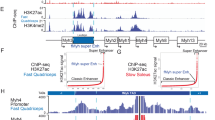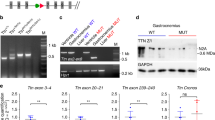Abstract
We used an exon-specific gene-targeting strategy to generate a mouse model deficient only in the SM-B myosin isoform. Here we show that deletion of exon-5B (specific for SM-B) in the gene for the heavy chain of smooth muscle myosin results in a complete loss of SM-B myosin and switching of splicing to the SM-A isoform, without affecting SM1 and SM2 myosin content. Loss of SM-B myosin does not affect survival or cause any overt smooth muscle pathology. Physiological analysis reveals that absence of SM-B myosin results in a significant decrease in maximal force generation and velocity of shortening in smooth muscle tissues. This is the first in vivo study to demonstrate a functional role for the SM-B myosin isoform. We conclude that the extra seven-residue insert in the surface loop 1 of SM-B myosin is a critical determinant of crossbridge cycling and velocity of shortening.
This is a preview of subscription content, access via your institution
Access options
Subscribe to this journal
Receive 12 print issues and online access
$209.00 per year
only $17.42 per issue
Buy this article
- Purchase on Springer Link
- Instant access to full article PDF
Prices may be subject to local taxes which are calculated during checkout




Similar content being viewed by others
References
Nagai, R., Larson, D. M. & Periasamy M. Proc. Natl Acad. Sci. USA 85, 1047–1051 (1988).
Babij, P. & Periasamy, M. J. Mol. Biol. 210, 673–679 (1989).
Nagai, R., Kuro-o, M., Babij, P. & Periasamy, M. J. Biol. Chem. 264, 9734–9737 (1989).
Paul, R. J., Hewett, T. E. & Martin, A. F. Adv. Exp. Med. Biol. 304, 139–145 (1991).
Hamada, Y. et al. Biochem. Biophys. Res. Commun. 170, 53–58 (1990).
Kelley, C. A., Takahashi, M., Yu, J. H. & Adelstein, R. S. J. Biol. Chem. 268, 12848–12854 (1993).
White, S., Martin, A. F. & Periasamy, M. Am. J. Physiol. 264, C1252–C1258 (1993).
Spudich, J. A. Nature 372, 515–518 (1994).
Sweeney, H. L. et al. J. Biol. Chem. 273, 6262–6270 (1998).
Murphy, C. T. & Spudich, J. A. J. Muscle Res. Cell. Motil. 21, 139–151 (2000).
Wetzel, U., Lutsch, G., Haase, H., Ganten, U. & Morano, I. Circ. Res. 83, 204–209 (1998).
DiSanto, M. E., Cox, R. H., Wang, Z. & Chacko, S. Am. J. Physiol. 272, C1532–C1542 (1997).
Jones, R., Steudel, W., White, S., Jacobson, M. & Low, R. Cell Tissue Res. 295, 453–465 (1999).
White, S. L., Zhou, M. Y., Low, R. B. & Periasamy, M. Am. J. Physiol. 275, C581–C589 (1998).
Babu, G. J., Warshaw, D. M. & Periasamy, M. Microsc. Res. Tech. 50, 532–540 (2000).
Rovner, A. S., Freyzon, Y. & Trybus, K. M. J. Muscle Res. Cell. Motil. 18, 103–110 (1997).
Lauzon, A. M. et al. J. Muscle Res. Cell. Motil. 19, 825–837 (1998).
Lauzon, A. M., Trybus, K. M. & Warshaw, D. M. Acta Physiol. Scand. 164, 357–361 (1998).
Loukianov, E. V., Loukianova, T. & Periasamy, M. Biotechniques 23, 376–380 (1997).
Morano, I. et al. Nature Cell Biol. 2, 371–375 (2000).
Loukianov, E. et al. Circ. Res. 83, 889–897 (1998).
Fuglsang, A., Khromov, A., Torok, K., Somlyo, A. V. & Somlyo, A. P. J. Muscle Res. Cell Motil. 14, 666–673 (1993).
Matthew, J. D., Khromov, A. S., Trybus, K. M., Somlyo, A. P. & Somlyo A. V. J. Biol. Chem. 273, 31289–31296 (1998).
Huang, Q.-Q., Fisher, S. A. & Brozovich, F. V. J. Biol. Chem. 274, 35095–35098 (1999).
Barany, M. J. Gen. Physiol. 50, 197–218 (1967).
Sobieszek, A. & Jertschin, P. Electrophoresis 7, 417–425 (1986).
Gokina, N. I. & Osol, G. Am. J. Physiol. 274, H1920–H1927 (1998).
Mulvany, M. & Halpern, W. Circ. Res. 41, 19–26 (1977).
Acknowledgements
This work was supported by the National Institutes of Health Grant HL 38355-15 (to M.P.) and American Heart Association (Ohio Valley) Postdoctoral fellowship 0020372B (to G.J.B). The authors thank K. McElory-Yaggy for expert assistance for the experiments with mesenteric vessels.
Author information
Authors and Affiliations
Corresponding author
Rights and permissions
About this article
Cite this article
Babu, G., Loukianov, E., Loukianova, T. et al. Loss of SM-B myosin affects muscle shortening velocity and maximal force development. Nat Cell Biol 3, 1025–1029 (2001). https://doi.org/10.1038/ncb1101-1025
Received:
Revised:
Accepted:
Published:
Issue Date:
DOI: https://doi.org/10.1038/ncb1101-1025
This article is cited by
-
Loss of smooth muscle myosin heavy chain results in the bladder and stomach developing lesion during foetal development in mice
Journal of Genetics (2018)
-
Ablation of smooth muscle caldesmon affects the relaxation kinetics of arterial muscle
Pflügers Archiv - European Journal of Physiology (2013)
-
Expression of myosin isoforms in the smooth muscle of human corpus cavernosum
International Journal of Impotence Research (2007)



